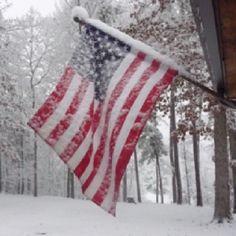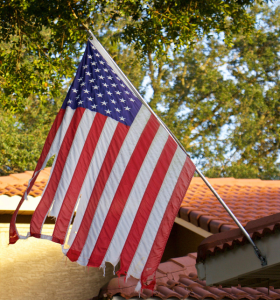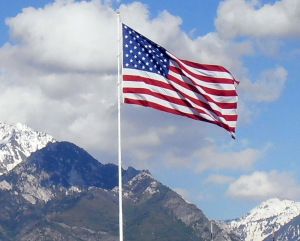Flying the U.S. Flag in “Inclement” Weather
John M. Hartvigsen
It’s late December, winter has hit most the the U.S. and baby it’s cold out there!
Past versions of the U.S. Flag Code advised against flying the flag in “inclement” weather. The word “inclement” comes from Latin and means not pleasant or not merciful. While this may seem logical not to fly the flag is “inclement” weather, it does differ from military tradition.
Historically, the U.S. Army has always displayed has a storm flag during stormy weather. It is made of the same materials as the larger Post Flag and the even larger Garrison Flag. Why is it smaller in size? It is easier to handle in strong winds and if it becomes soaked during a storm, it dries out faster than a large flag, and it is easier to find a place to dry out a smaller flag.
Civilians normally fly the same size flag whatever the day, so what should they do when the weather turns unpleasant? With a vague understanding of the word “inclement” Americans avoided flying the flag even if a brief rain shower passed, and the Flag Code was amended to read, “The flag should not be displayed on days when the weather is inclement, except when an all-weather flag is displayed.” [Title 4 U.S.C § 6. (c)] Now we may not only need to ask what constitutes “inclement weather” but what is “an all-weather flag”?
Today, most flags made are “all-weather” in their construction and materials—at least to a point. Some flags do not fit this definition:
- Silk or taffeta materials are made for indoor display or parades.
- Prints on thin and inexpensive synthetic materials.
- Paper or plastic flags used for decoration.
All-weather flags:
- Are constructed from sturdy natural or man-made flag grade materials such as wool, cotton, nylon, rayon or polyester.
- Are made using colorfast dyes.
- Have canvas heading with metal grommets.
- Have double stitched hems fields.
- Have a sturdy hem at the fly end with multiple rows of stitching.
- May be of either sewn or printed.
Even a high quality all-weather flag, since it is exposed to the elements when flying, will wear out in time. However, its life can be expanded if its exposure to severe weather conditions is avoided. Point to remember:
- High winds put a strain on a flag’s fibers and stitching that is more destructive than a brief rain or snow shower.
- Heavy rain over longer periods can soak a flag making it heavy on the halyards. A small nylon flag will dry out in the wind, but larger flags may need to be lowered and placed were they can dry out.
- Flags flown twenty-four hours a day over long periods, not only need to be lighted, but they need to be rotated regularly to give fibers a chance to rest and to allow inspection for wear and damage. A small tatter or tear left unrepaired will grow to a size that it cannot be repaired.
- Lighted or not, do not leave a flag flying until it is tattered, torn and worn out.
- Never fold or store a wet flag. Make sure they have completely dried out if they became wet.
- A flag that is faded, soiled, torn or frayed should be lowered and replace before its unsightly appearance is obvious to observers on the ground.
Inclement? All-weather flags? While it is not disrespectful to fly the Stars and Stripes in “unpleasant weather,” common sense should be the rule in lowering the flag when weather becomes “unmerciful.” It may be more import to take down a flag during high wind. Even more important that we regularly inspect, clean and repair a flag that it may fly proudly over the “land of the free and the home of the brave.”
May the Stars and Stripes fly beautifully and proudly throughout 2019.



